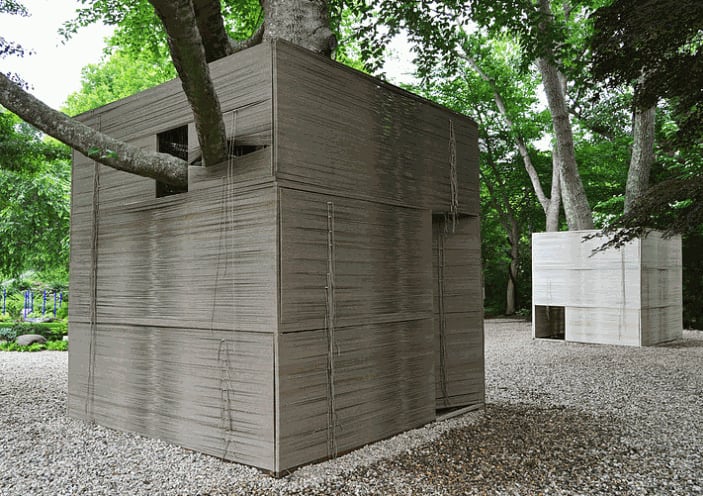
Toni Ross has devoted most of her career to stoneware sculpture, producing bodies of work that seek the austerity and gravitas of certain forms of ancient art—through muted palettes, textural layering, and rearticulated remnants. Her ongoing fixation with the cubic form has rendered tense, mysterious stoneware blocks; heavy matter that she regularly offsets with cracks and partial openings (pointing to the obscure, cloistered space inside) or by wrapping string in a gesture wavering between support and clinginess. The artist’s last projects, two successive site-specific insrallations and one inter, expand all these lines of thought into colossal experiences.

Toni Ross
Untitled, 2015

Toni Ross
Untitled, 2016

Toni Ross
Untitled, 2015
In “Permanent Transience” (on view between the summers of 2016 and 2017 as part of the Parrish Art Museum’s off-site “Roadshow” series), Ross enclosed three existing boulders with massive cubes made of straw—or rather, many bails of straw tied seamlessly within rebar frameworks—transforming the visible parts of the rocks into molten, otherworldly matter. “Sanctuary Entwined,” on view between the summer of 2017 and the spring of 2018, was created for LongHouse Reserve in East Hampton, the bucolic 16-acre estate and outdoor museum established by renowned textile designer Jack Lenor Larsen. For this project, Ross intervened three trees that live on a gravel pathway with large cubessteel structures completely enveloped in a total of 45 miles of hemp twine. A bleached hemp cube sat at the bottom of a native oak, its three-way trunk emerging from the top like antennae. A larger, slightly darker cube allowed the limbs of a towering American beech to stretch out from its top and side. The smallest piece of the grouping, a burlap cube balanced on an edge, appeared to be pierced and pinned down under the thin trunk of a weeping European beech.

“Permanent Transience” © Philippe Cheng (all four photographs)



“Sanctuary Entwined”
“When I first conceived the piece,” says Ross, “it was just a couple of months after Trump had tried to ban Muslims from the country and there were many meetings happening out here for Latino residents and really upsetting conversations about what they needed to be prepared for. So, the question of what makes a space safe, and what that means to one person or another, was really on my mind.” Consequently, the two largest pieces in “Sanctuary Entwined” were made to allow viewers inside. Expectedly, the interiors pay homage to the graceful simplicity of the trees gripped to the ground, connected like beams to the crowns soaring above. Unexpectedly, the experience is multisensory and deeply meditative—a subtler “Earth Art” version Yayoi Kusama’s or Pipilotti Rist’s digital media immersions. Within the pliable walls of twine, it smelled faintly of bark and moss; on clear days, shafts of sunshine sifted through the spaces between the strings of twine, producing ephemeral drawings with light that interwove with existing patterns or dissolved in patches of brightness that pooled in from where the trunks surfaced out of the sculptures.

© Philippe Cheng (all four photographs)



In one of a series of in situ panel discussions that Ross organized during the summer of last year, editor Uzoamaka Maduka observed: “[for women artists] there’s a sense that nature isn’t something that’s there to be mastered or controlled, but rather something that is to be collaborated with … For me that’s very different than the traditional way of encountering the intensity of nature and perhaps might be something that distinguishes it from a more male and hegemonic perspective.” Ross’s vision of the cube as a sanctuary (one contained by and encapsulating nature) in fact opposes the male driven minimalist idealization of the cube as the perfect non-figurative form only representing its own abstract unchanging qualities, and thus fundamentally removed from the cycles and mutations of the natural world. Donald Judd’s concrete and mirrored cubes, Sol LeWitt’s systematic variations of modular cubes, Larry Bell’s coated glass cubes, and Richard Serra’s heavy stacked steel blocks are all, for better or worse, emblems of control. Ross’s large-scale work, while still largely self-effacing, upholds its status as art-object while almost dissolving into the landscape. When the first blooms of spring settled on LongHouse Reserve,“Sanctuary Entwined” had endured three full seasons and their imprints of mold and rust. Under sun, precipitation, and snow, protein-loaded hemp acted like a restless living organism, ceaselessly contracting and relaxing in synchrony with the moisture in the air. After rain showers, loose strings from knots left untrimmed coiled together as snakes would. Like the two sides of the brain engaged in battle, the accumulated tensile strength of the twine continuously challenged the exact geometry of the steel.

© Janet Goleas (all three images)



© Philippe Cheng
“I realized that in the end you’re not in charge,” says Ross. “You have to be a part of a conversation with the materials and realize that it is what it is … I’m not creating yet another thing to exist in this world, but rather it’s here for a while and then it goes back to the earth. Then I create another one.” The protective, compulsive actions of wrapping and weaving involved in the making of the pieces in “Sanctuary Entwined,” with their emphasis on process, are vulnerable and transient only because they’re part of a mutable, self-regenerating practice. This is the biggest accomplishment of Ross’s large-scale work so far, the embodiment of a very contemporary fluidity between notions of strength and frailty—or permanence and decay—as a possible means for subversion.

© Janet Goleas (all four images). Ross’s most recent site-responsive intervention (“Found Lines” on the grounds of Berkshire Botanical Gardens in Stockbridge, MA.), part of “Beautiful Strangers,” an exhibition curated by James Salomonith. With “Found Lines” Ross examines the life of trees and the quiet language that seems to emerge from the patterns held within bark. The installation consists of 18 – 24K gold leaf, applied by hand to three thriving trees; each provoking a separate and distinct imagery.


